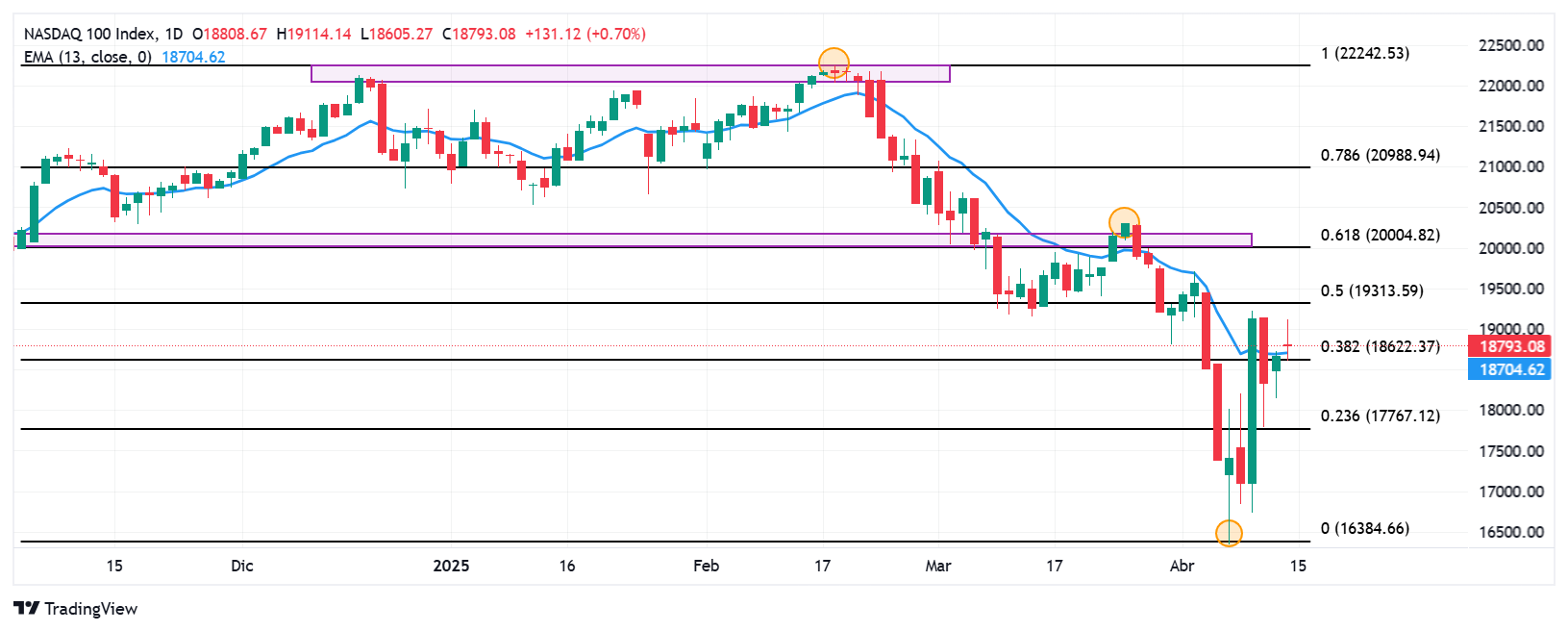- Nasdaq 100 rises 0.70% daily, quoting at the time of writing at 18,793.
- PDD Holdings shares win 4.71% today, reaching maximums of April 8.
- The values of Palantir Technologies (PLT) rebound 4.60% in the day, visiting maximum of March 25 at 97.33 $.
The Nasdaq 100 established a daily minimum in 18,605, where it found buyers who promoted the maximum index of April 10 in 19,114. At the moment, the Nasdaq 100 operates over 18,793, winning 0.70% today.
Palantir Technologies and PDD Holdings keep Nasdaq 100 in positive territory
Palantir Technologies titles have a gain of 4.60% on Monday, reaching March 25 in 97.33 $ after the acquisition of the Maven Intelligence System by NATO, which allows the efficiency in military operations based on artificial intelligence.
In the same tune, the shares of PDD Holdings (PDD) rise 4.73% today, reaching maximum of April 8 by $ 99.10, signing its second consecutive day with profits.
The Nasdaq 100 rises 131 points in the first session of the week, consolidating at maximum April 10 in 18,793 after Trump’s tariff adjustment, modifying the rate from 145% to 20% on electronic products from China.
Technical levels at Nasdaq 100
The Nasdaq 100 established a short -term support given by the minimum of April 7 in 16,347. Upwards, the closest resistance is located in 20,304, maximum of March 25. The next key resistance is at 22,241, a pivot point on February 18.
NASDAQ 100 DAILY GRAPH

NASDAQ FAQS
The Nasdaq is an American stock exchange that began being an electronic value quoter. At first, the Nasdaq only offered quotes of extraburstile values (OTC), but later also became a bag. In 1991, Nasdaq had grown up to 46% of the entire US stock market. In 1998, it became the first US stock exchange to offer online negotiation. The Nasdaq also prepares several indexes, the most complete of which is the Nasdaq Composite, which represents the more than 2,500 Nasdaq values, and the Nasdaq 100.
The Nasdaq 100 is a large capitalization index composed of 100 non -financial companies of the Nasdaq stock exchange. Although it only includes a fraction of the thousands of Nasdaq values, it explains more than 90% of the movement. The influence of each company in the index is weighted based on stock capitalization. The Nasdaq 100 includes companies that are very focused on technology, although it also encompasses companies from other sectors and outside the United States. The annual average profitability of Nasdaq 100 has been 17.23% since 1986.
There are several ways to operate with the Nasdaq 100. Most of the Stred Betting Retail Corridors and Platforms offer bets through contracts by difference (CFD). For long -term investors, quoted funds (ETF) operate as shares that mimic the movement of the index without the investor having to buy the 100 companies that compose it. An example of ETF is the investment QQQ Trust (QQQ). Nasdaq 100 futures contracts allow specular to the future evolution of the index. The options provide the right, but not the obligation, to buy or sell the NASDAQ 100 at a specific price (exercise price) in the future.
There are many factors that promote Nasdaq 100, but mainly it is the aggregate performance of the companies that compose it, revealed in their reports of quarterly and annual results. American and world macroeconomic data also contribute, since they influence investors’ confidence, which is positive drives profits. The level of interest rates, set by the Federal Reserve (FED), also influences Nasdaq 100, since it affects the cost of credit, which many companies depend largely. Therefore, the level of inflation can also be an important factor, as well as other parameters that influence the decisions of the Federal Reserve.
Source: Fx Street
I am Joshua Winder, a senior-level journalist and editor at World Stock Market. I specialize in covering news related to the stock market and economic trends. With more than 8 years of experience in this field, I have become an expert in financial reporting.







